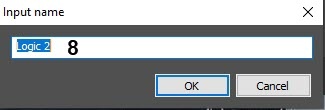
Go to documentation repository
The logic of event handling is a sequence of actions that should be performed by an operator when processing an event in the Incident manager.
6 elements are used to perform the actions:
- Image. The operator can add a frame from a video camera or an arbitrary image to the report. Images from maps or cameras can be added automatically.
- Button. The button can be used to close the event handling interface and/or to open a report.
- Combobox. The operator can select values from one or several lists.
- Comment. The operator can add a comment while handling the event.
- Radio button. The operator can choose one of the suggested values.
- Checkbox. The operator can set one or more checkboxes.
The number of elements that can be used in the logic and the number of actions that the operator should perform are not limited. After the operator performed any action, the next action that should be performed is set in the element settings; a macro can be executed as well, if necessary. The sequence of actions can be determined by the operator's actions in the previous steps.
Create and configure the logic as follows:
- Go to the Logic tab of the Incident handler object settings panel.
- Click the + button (2) and in the appeared window enter the name for the new logic (8). You can also create a copy of an existing logic, for this it is necessary to select the logic in the list (4) and click Create copy (1). As a result, the new logic will appear in the list (4).
- In the list of logics (4), select the logic to be configured.
- Add the required number of elements to the logic (5). To add a row to the table, select the last row and press the ↓ key on the keyboard. To delete rows from the table, use the Ctrl + Del key combination.
- In the Element ID column, enter the name of each element.
- In the Multitasking column, set the ability to switch to processing other events when one event is processed while on the selected logic element:
Select Deny, so that when this element appears, the operator cannot switch to processing another event until the operator moves to the element with the Allow value or completes processing the event (default);
Select Allow, so that when this element appears, the operator can proceed to processing another event.
Select the element that will be displayed first for the operator when processing the event. To do this:
- Select an element in the table.
- Click the Edit button (6).
- In the Starting element drop-down list, select Yes.
Click the OK button.
As a result, a check mark will be displayed next to the selected element in the Starting column of the element table.Note
If the starting element is not selected, then it will be the first element in the list.
- Configure each element of logic and their correspondence (see Configuring the elements).
- Repeat steps 3-7 for all added logics.
- Click the Apply button (7).
The logic of event handling is configured. To delete a logic, select it in the list of logics (4) and click the - button (3).
Note
The logic of event handling is applied to an event at the moment when the event gets into the Incident handler and is displayed in the Incident manager. Accordingly, if you change the logic, the updated logic will be applied to the events that occurred after it was changed. If a group processing of the events is enabled, the updated logic will be applied to a new group of the events after the existing group is closed.


